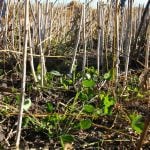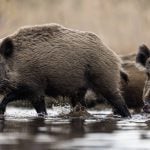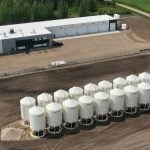On the first of May every spring, Kevin MacIsaac heads out on the water with his son-in-law, a lobster fisherman, to set the 300 traps they’re allowed under their quota system. For the next month, the pair are back out on the water to empty those traps — daily, at four in the morning.
On the island, they say it’s cold as the hinges of hell on the Atlantic at four a.m. in early May. But Prince Edward Islanders are made of stern stuff.
“You have to be there when it’s calm,” explains MacIsaac. “There’s a little boom on the boat that hooks onto the trap and pulls it out of the water. When it gets to the boat, the captain and helper pull the lobster out and put in fresh bait.”
Read Also

Farm peer groups still provide value
A look at whether farm peer groups are still relevant.
In his life as a potato farmer, MacIsaac also knows about getting up in the middle of the night, but for a different reason that has nothing to do with mechanics or science. Instead, farmers have found that getting into the field as early as three a.m. is their best way to grow a sustainable crop while also keeping their neighbours happy, or at least to keep them from complaining.
On this island, as you’ll see, that’s a big deal.
Soaring numbers
P.E.I. is Canada’s smallest province, at 5,660 square kilometres, and also its most densely populated (roughly 158,000 at Statistics Canada’s last count). Its famous red dirt is mainly potato land; the Island still produces more potato tonnage on average than any other Canadian province.
In the popular imagination, P.E.I.’s agriculture is still a lot like the small mixed cattle-cropping operation run by Matthew Cuthbert in L.M. Montgomery’s Anne of Green Gables series, which helps explain its draw as a tourist destination.
Before the COVID-19 pandemic, most of the Island’s tourists came from China and Japan, where Anne of Green Gables is a mainstay of school curricula. These days, the pandemic has stymied tourism, but MacIsaac says quite a number of the Island’s emigrants are permanently returning, working corporate jobs from home and taking advantage of small-town community life.
It doesn’t look the same as it did in Anne’s days, though. P.E.I. farmers have had to adapt to survive.
It would be hard to find someone who knows more about P.E.I.’s agriculture than MacIsaac. Not only is he the outgoing general manager at United Potato Growers of Canada, he’s also a veteran potato farmer.

When MacIsaac was growing up in the 1960s near Souris, on the northeastern side of the Island, his father grew potatoes on a 50-acre plot and stored them in the stone-walled basement under the kitchen. His dad had to move the spuds by March or they’d start to sprout in the humidity, and he’d haul them to the deep-water port in town heading to Boston, New York or Puerto Rico on ships that brought rum and molasses to the Maritimes.
It wasn’t easy work, and a lot of farmland was abandoned or sold while landowners went to work in Hamilton factories. In 1969, the signing of P.E.I.’s Comprehensive Development Plan, designed to help fund agricultural research and development and to boost farm consolidation, brought new life to the embattled potato industry.
Farmers like MacIsaac’s father began expanding their operations in the ’60s and ’70s, and advances in industrialized storage technology in the 1980s pushed the industry further. Equipment, says MacIsaac, allowed for economies of scale on P.E.I.
Close industries
Only since he retired has MacIsaac been able to get out on the lobster boat on the first of May. Farmers are out planting then, and still in the fields June 1, when the traps are collected for the season. In more ways than one, lobster and potatoes rub along pretty well on the Island: many of the lobster industry’s seasonal workers switch to driving potato trucks in the fall.
“The trucking industry is (also) so intertwined with all of this,” says MacIsaac. “Whether you’re delivering to a plant, or to Boston, everything has to move by truck. There’s a big conversation among trucking brokers and producers. When you need to haul lobster, a lot of potatoes have already been hauled, and in the fall the trucks are hauling potatoes.”
The relationship between the potato and tourism industries isn’t always quite so sanguine.
In the summer months, when tourism hits its stride, the Island’s population increases almost tenfold.
Unlike in Manitoba or Alberta, P.E.I. potato fields aren’t isolated in farming heartlands, away from urban centres. On the island, it’s a rare field that doesn’t run down to the seashore, which is where the holiday cottages are. Between June and September, trucks and tractors have to share the road with tourists, and as fields abutt holiday homes, keeping landowners and tourists happy and getting the job done can be a balancing act, says MacIsaac.
“You have to do the spraying early in the morning when it’s calm,” he says. “But I have (had) all sorts of experiences early in the morning where landowners say they don’t want you coming before eight a.m. Then they say, ‘Why don’t you come in the middle of the day?’ But you can’t do it when it’s windy. So you do it at night, but then you have to work day and night.”
It’s a small minority of landowners who aren’t willing to make compromises with farming neighbours, he says. Mostly, they stay on good terms.
Still, scrutiny of farming and farmers’ practises has intensified over the years.
Barry Green grows 500 acres of potatoes near Bedeque, an hour west of Charlottetown. He says farming in his region is basically “farming in a suburb”: many farmers get up at three a.m. so they can spray crops without angering non-farming neighbours.
There’s concern locally about the risk of chemical inputs contaminating the water supply, a concern which is shared by some farmers, says Green. But so far, he argues, the science shows farmers aren’t harming the water, and nobody does more than farmers to steward the land.
On his farm, only a third of the land is planted to potatoes in a given year, in compliance with the province’s requirement of minimum three-year rotations. Green’s potatoes are irrigated, but the irrigation water is pumped from retention ponds, not rivers.
As well, most of his land was cover-cropped last year, he says, and the farm was fully zero till in 2021.
“Because of our size and dense population, there’s a very strong environmental movement, and there doesn’t seem to be a lot of recognition of all the challenges farms have to face trying to do the right thing,” says Robert MacDonald, a semi-retired farmer and former owner of East Coast Grains and Oilseeds (now Harris Seeds) in Belfast, P.E.I. “And they are trying to do the right thing. It would have been hard to find a field 25 years ago that was set up to stop the flow of water. Now, it’s quite commonplace to see fields that are managed with berms and contours to decrease the flow of water during severe rain events.”
MacDonald’s father managed the land from the 1950s until MacDonald and his brother took it over in 1984. Originally, they grew tablestock and seed potatoes, but over time markets and customer demands changed. Eleven years ago, when they were unable to obtain enough processing contracts to keep the farm viable, they made a complete switch to growing corn, soybeans and wheat.
MacDonald says that in the past, they’d have to go into every field a minimum of three times in the spring: a couple of times to level ground, and then a final time to fertilize and plant the crop. After they purchased a no-till grain planter, they could do it all in one pass. “But a lot of (people) don’t look at that and say, ‘That’s cutting back a lot of impacts on the environment.’ And they also don’t realize that this new machine costs in excess of a quarter million dollars,” he says.
Like farmers across Canada, P.E.I. producers are worried non-farmers simply aren’t getting the message, and don’t understand that farmers are pro-environment.
“It’s eased off a lot over the last few years, but it was brutal. If you let that get at you, it’s very hard to take and you get frustrated because you’re doing everything you possibly can to ease the harm to the environment.
“On P.E.I., because of the size, we’re farming around people’s houses. They don’t like you leaving the ground bare in the winter, they don’t like runoff. They don’t seem to recognize that neither does the farmer. You can only do the best you can, but at the end of the day you’ve got to crop that field,” he says. “If these people would just realize, if my ground won’t grow a crop, I’m cutting my own throat.”

Community support
P.E.I.’s communities offer more than just critiques of farmers and farming practices. When the rubber hits the road, they extend a hand.
This past winter, when the potato wart crisis hit the Island, Green says the community rallied around farmers, and “buy local” became a byword when it mattered most. Since the crisis began, Green and the other potato farmers interviewed for this story hadn’t heard a word of complaint from their non-farming neighbours on environmental matters.
In general, farmers are pretty collegial with each other. “Most people are reasonably successful. You’re in competition a little bit with your neighbours, but if anything goes wrong they’re the first people at your door to help out. It’s friendly competition, I call it. If you have an issue, your neighbour is there to help you out,” says Green.
Where farmers do need more support, says MacDonald, is from the federal government. “Very few in the federal department realize how important farming is to P.E.I. and the Maritimes,” he says. “Three years ago we had a hurricane come through and decimate the corn crop. It took the feds over a year to (finally tell us) the storm didn’t fit the parameters of the safety net programs we have. It knocked the wind out of a lot of us.”
When the potato wart crisis hit in the fall, a delegation of potato farmers, MacDonald among them, and provincial government officials headed to Ottawa to meet with the Canadian Food Inspection Agency. “They said, ‘Thank you very much (for coming). We didn’t realize how much this meant to the industry.’ But the sad part is, these are supposed to be educated people who should know how important potato production and farming is to the local economy. They should be working for us and with us to design safety net programs to assist farmers when weather and trade events beyond our control negatively impact our ability to (stay) viable and contribute to the economy,” he says.
I ask MacDonald about the federal government’s recent investment of $28 million in emergency funding to help move fresh product, and its pledge to increase AgriStability payments from 50 per cent to 75 per cent of anticipated income.
“Those are all good talking points that politicians and federal bureaucrats use to deflect criticism about ineffective safety net programs. (But) nobody really understands how the AgriStability program works. It’s a very complicated program. It takes over a year to get assistance out of it. And they don’t pay a full dollar,” he says. “If they think 28 million dollars is going to help out this issue — it’s not even a bandaid. I’d take every dollar I get, but it’s not going to solve the problem. What would solve the problem is boots on the ground getting the evidence they need to get the market open.”
MacDonald believes the potato wart issue may mean some producers exit the industry for good. That land will be snapped up by other farmers. But the fewer the farmers, the greater the risk during future phytosanitary crises, and stress on the industry.

Back in 2008, when MacIsaac was chair of the P.E.I. Potato Board, there were over 300 names on the grower list, he says. These days, that number is closer to 160 or 170.
“The numbers have almost halved in that period of time, because farms have gotten bigger, someone has gotten out of the business, and that property was almost immediately picked up by a neighbouring farm,” he says. “That is a bit of an issue in the country, (where) rural schools and hospitals are so dependent on numbers. The population in P.E.I. has moved substantially to Charlottetown and Summerside, but it’s declined in other areas.”
Social support is as essential in its way as government support. And so is technology, which MacIsaac calls a “saving grace.”
“When my father grew up, it took almost half a day to get to a major city, by train or on a horse,” he says. “Young farmers are on Twitter and Facebook, they have groups they meet with, they’ve very in tune with that, so that’s been a help.”
“You can grow anything”
Considering its size, and the mandatory one-in-three rotation across the Island, it’s staggering just how many potatoes are produced in the province each year. 2021 was a banner year for production, with the highest yields most producers had seen in a decade — a bitter irony for fresh producers, given the crisis to follow.
But P.E.I. plays host to small beef and dairy industries, too. And if you can find a market, P.E.I. is a great place to be a grain farmer, says MacDonald.
“I tell people you can grow just about any crop in P.E.I. that you can grow in the rest of Canada. Our biggest challenge is access to market. You can grow a big crop of canola but then you need to ship to Upper Canada, Montreal,” he says.
It costs roughly $80 a tonne for freight just to get it that far, he says. He can ship corn, soybeans or wheat out of the port in Halifax, he says. He pays $20 a tonne to get corn to Moncton, and $30 dollars to Halifax. “It makes more sense for us to grow crops we can market here. There is a small market for canola but it’s not as big as for corn or wheat,” he says.
It costs a lot to ship product out of P.E.I., but it also costs to bring in inputs. “We pay going in, and we pay going out. Transportation is a huge cost to the industry. A lot of these big companies try to average the costs out, but seed is still cheaper in Ontario than it is in P.E.I.”
Given the challenges producers face on the Island, what keeps them farming there? It’s more than the picturesque red dirt roads and green fields ending at the sea. Like everywhere else in Canada, it’s blood ties, and ties to the land.
MacIsaac has an enormous affection for P.E.I., and the producers he’s gotten to know in his role at the United Potato Growers.
He’s grateful, he says, that he had the chance to raise his own kids on the Island. And he’s grateful for the chance to get to know so many producers in his job at UPGC. “There are so many amazing people out there,” he says.
If you don’t like the work, it’s a tough job, says MacDonald. If you do, you can count yourself lucky to live and farm in a picture postcard. “You have to like to farm. Now that we’re growing grain, it’s great. The scenery is great in the spring when you’re planting crops. I overlook Nova Scotia all day long.
“It doesn’t matter how tough things get, the neighbours are always around, and when something bad happens, people are there to help out. The Island supports farmers.”
















